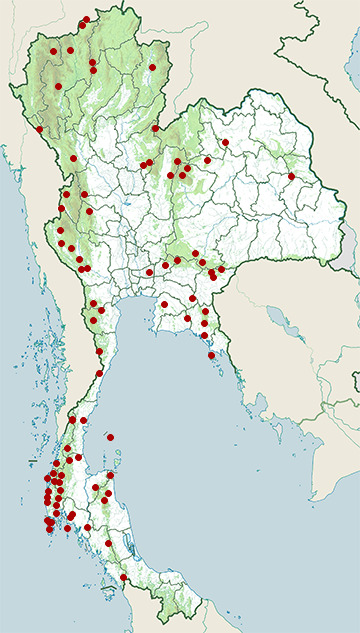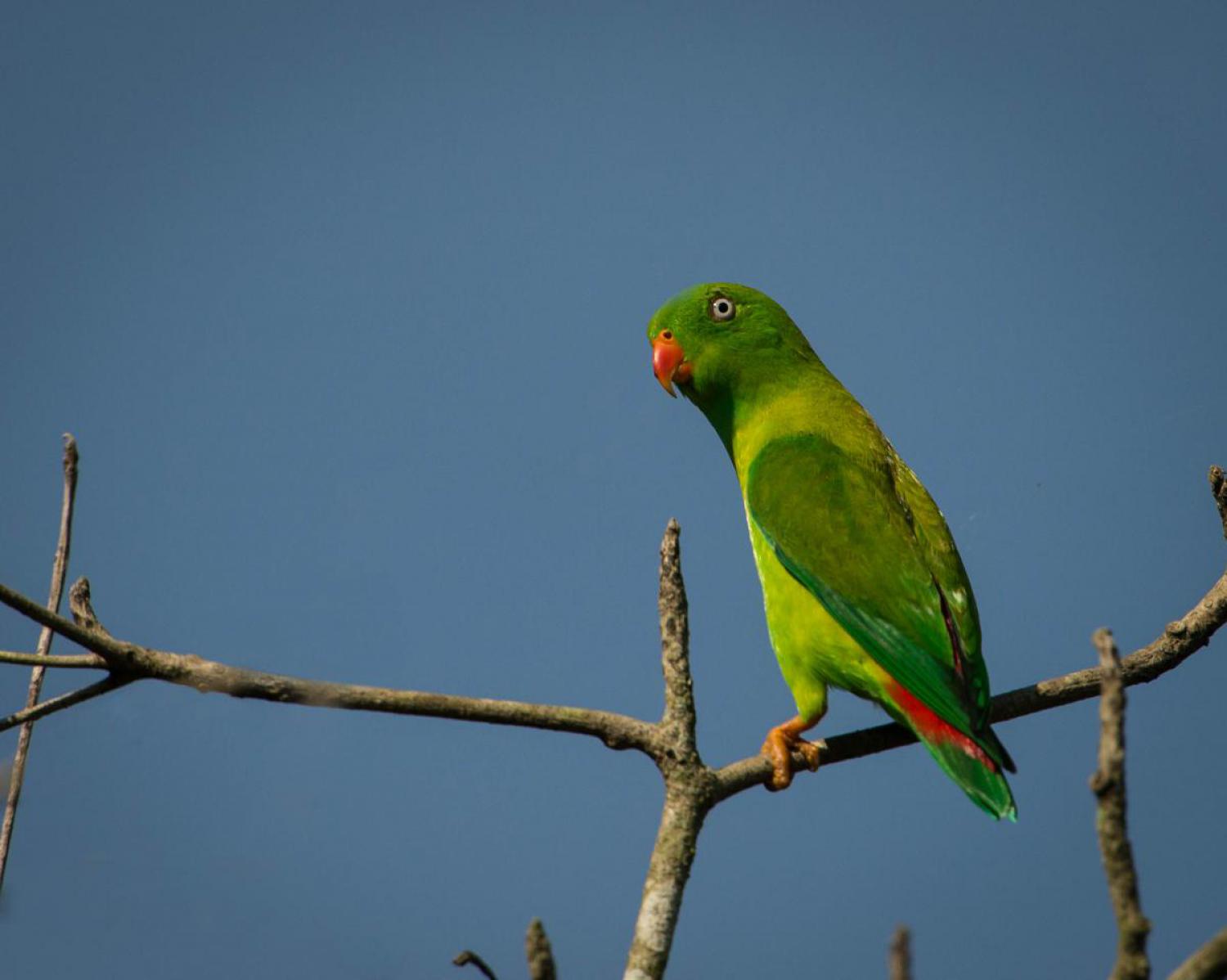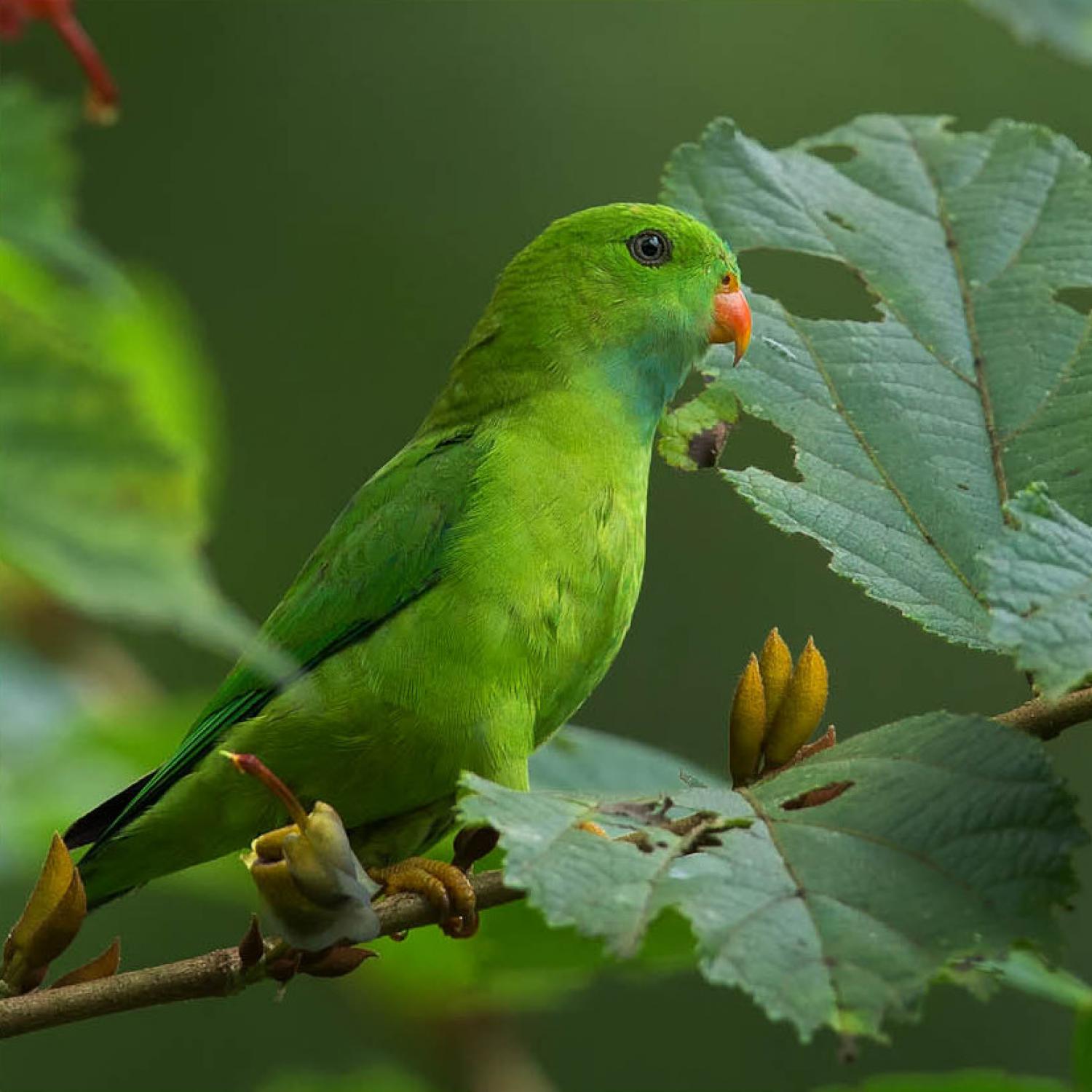Species of Thailand
Vernal hanging parrot
Loriculus vernalis
Anders Sparrman, 1787
In Thai: นกหกเล็กปากแดง
The vernal hanging parrot (Loriculus vernalis) is a small parrot which is a resident breeder in the Indian subcontinent and some other areas of Southeast Asia. It undergoes local movements, driven mainly by the availability of the fruit, seeds, buds and blossoms that make up its diet. They frequent the banyan tree for the fruit and plantain trees for the nectar from the flowers.
This is a small, mainly green hanging parrot, only 14 cm long with a short tail. The adult male has a red rump and bill, and blue throat patch. The female has a green patch. Vernal hanging parrot is a bird of dry jungle and cultivation. It nests in holes in trees, laying 2-4 white eggs. Immature birds have a duller rump, and lack the throat patch. Vernal hanging parrot is less gregarious than some of its relatives, and is usually in small groups outside the breeding season. Its flight is swift and direct, and the call is a raucous chattering.
In Sri Lanka, it is replaced by the very similar endemic Sri Lanka hanging parrot, (L. beryllinus).
Breeding
Vernal hanging parrots nest in tree cavities. The nests are lined with fragments of leaves. There are usually three eggs in a clutch. The eggs are white in color. The female incubates the eggs for 20 days and the chicks leave the nest about 33 days from hatching.
This article uses material from Wikipedia released under the Creative Commons Attribution-Share-Alike Licence 3.0. Eventual photos shown in this page may or may not be from Wikipedia, please see the license details for photos in photo by-lines.
Category / Seasonal Status
BCST Category: Recorded in an apparently wild state within the last 50 years
BCST Seasonal status: Resident or presumed resident
Scientific classification
- Kingdom
- Animalia
- Phylum
- Chordata
- Class
- Aves
- Order
- Psittaciformes
- Family
- Psittacidae
- Genus
- Loriculus
- Species
- Loriculus vernalis
Common names
- Thai: นกหกเล็กปากแดง
Conservation status

Least Concern (IUCN3.1)
Photos
Please help us review the bird photos if wrong ones are used. We can be reached via our contact us page.
Range Map

- Ao Phang-Nga National Park
- Ban Bueng District, Chonburi
- Chae Son National Park
- Chiang Dao Wildlife Sanctuary
- Doi Inthanon National Park
- Doi Lang
- Doi Pha Hom Pok National Park
- Erawan National Park
- Huai Kha Khaeng Wildlife Sanctuary
- Huai Yang Waterfall National Park
- Kaeng Krachan National Park
- Kaeng Krung National Park
- Khanom District, Nakhon Si Thammarat
- Khao Ang Rue Nai Wildlife Sanctuary
- Khao Chamao - Khao Wong National Park
- Khao Chong
- Khao Khitchakut National Park
- Khao Laem National Park
- Khao Lak - Lam Ru National Park
- Khao Luang National Park
- Khao Nan National Park
- Khao Phanom Bencha National Park
- Khao Phra - Bang Khram Wildlife Sanctuary
- Khao Phra Thaeo Wildlife Sanctuary
- Khao Soi Dao Wildlife Sanctuary
- Khao Sok National Park
- Khao Yai National Park
- Khlong Nakha Wildlife Sanctuary
- Khlong Phanom National Park
- Khlong Saeng Wildlife Sanctuary
- Khon San District, Chaiyaphum
- Khun Chae National Park
- Khura Buri District, Phang Nga
- Ko Chang National Park
- Ko Phra Thong
- Ko Tao
- Kromluang Chumphon Wildlife Sanctuary
- Kui Buri National Park
- Mae Moei National Park
- Mae Wong National Park
- Mueang Chumphon District, Chumphon
- Mueang Krabi District, Krabi
- Mueang Nakhon Nayok District, Nakhon Nayok
- Mueang Phang Nga District, Phang Nga
- Mueang Phuket District, Phuket
- Nam Nao National Park
- Namtok Phlio National Park
- Noen Maprang District, Phitsanulok
- Nong Ya Plong District, Phetchaburi
- Pachee River Wildlife Sanctuary
- Pai District, Mae Hong Son
- Pang Sida National Park
- Pha Nam Yoi Forest Park
- Phato District, Chumphon
- Phi Phi Islands
- Phu Foi Lom National Park
- Phu Khiao Wildlife Sanctuary
- Phu Suan Sai National Park
- Phu Wiang National Park
- Sai Yok District, Kanchanaburi
- Sakaerat Environmental Research Station
- Salak Pra Wildlife Sanctuary
- Sirinat National Park
- Sri Nakarin Dam National Park
- Sri Phang-nga National Park
- Ta Phraya National Park
- Tai Rom Yen National Park
- Taksin Maharat National Park
- Takua Pa District, Phang Nga
- Tat Mok National Park
- Tha Chana District, Surat Thani
- Thai Mueang District, Phang Nga
- Thalang District, Phuket
- Thale Ban National Park
- Tham Sakoen National Park
- Thanyaburi District, Pathum Thani
- Thap Lan National Park
- Thong Pha Phum District, Kanchanaburi
- Thung Salaeng Luang National Park
- Thung Yai Naresuan Wildlife Sanctuary
- Ton Pariwat Wildlife Sanctuary
- Umphang Wildlife Sanctuary
- Wang Mai Forest Restoration Project
- Watthana Nakhon District, Sa Kaeo



